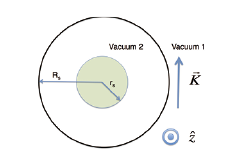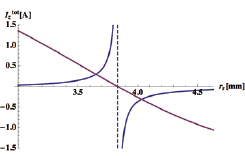Chiral Magnetic Effect in Condensed Matter Systems
Oshikawa Group
Relativistic massless fermions in 3+1 dimensions exhibit so-called chiral anomaly where the chiral symmetry, which is a symmetry of the Lagrangian, is broken due to quantum effects. This results in the violation of the individual conservation of the number of left-handed and right-handed fermions, allowing them to change to each other. Chiral magnetic effect (CME), an induction electric current parallel to the applied external magnetic field is one of the most intriguing phenomena related to this chiral anomaly. Due to the time reversal symmetric nature of CME, the current induced through CME is non-dissipative so that it has potential applications to the low-energy consuming electronics.

Fig. 1. Schematic picture of our setup. A solenoid (radius Rs) is represented as a surface current K between the two vacua. Inside them, a cylindrical sample (radius rs) is placed.

Fig. 2. Blue line: Total current Itotz [A] for parameters μ0σch = 1 [mm], ω=100 [Hz], B = 1 [Gauss]. Red: J1(μ0σchrs) in an arbitrary unit. The current is resonantly enhanced for rs satisfying J1(μ0σchrs) = 0 represented by a dashed line.
Recently, it becomes possible to synthesize a family of three-dimensional materials, topological semimetals, where electrons have (3+1) dimensional relativistic band dispersion near the Fermi energy, similar to graphene in (2+1) dimensions. That is, in these materials, the relativistic massless fermions emerge in the low-energy effective theory. It is thus tempting to observe the chiral anomaly and CME in a tabletop experiment with a high-controllability which we cannot have in high-energy physics. Indeed, there are already several experimental reports that claim to have observed the chiral anomaly and CME in topological semimetals through the negative magnetoresistance in the presence of parallel electric and magnetic field. Although the negative magnetoresistance can be an indication of the chiral anomaly, it could arise from other mechanisms and thus is not a smoking-gun evidence for the chiral anomaly, let alone CME
In order to develop a direct and unambiguous probe of CME, we studied the interplay of CME and electromagnetism in matter. Since CME can be understood as a consequence of an extension of electromagnetism called Chern-Simons electromagnetism, transport properties are governed in a highly non-trivial manner by both electromagnetism and CME. As a concrete example, we performed an electromagnetic field analysis in the setup shown in Fig. 1. We demonstrated that the physically observed admittance is not simply proportional to the chiral magnetic conductivity, even when the transport is governed by the CME. Furthermore, we found that the CME-induced AC current is resonantly enhanced when the cross section matches the “chiral magnetic length” as shown in Fig. 2. Our results imply that the electromagnetism is fundamental for actual transports in topological semimetals and that proposals for their applications to future electronics need careful considerations on this issue.
References
- [1] H. Fujita and M. Oshikawa, arxiv: 1602.00687
